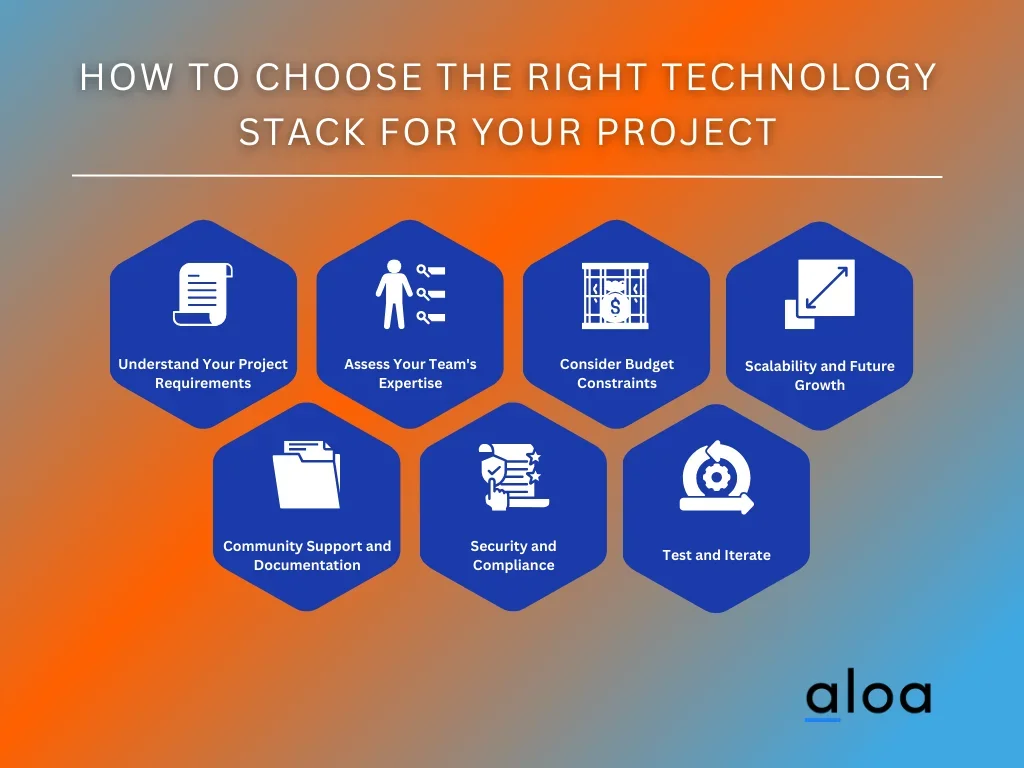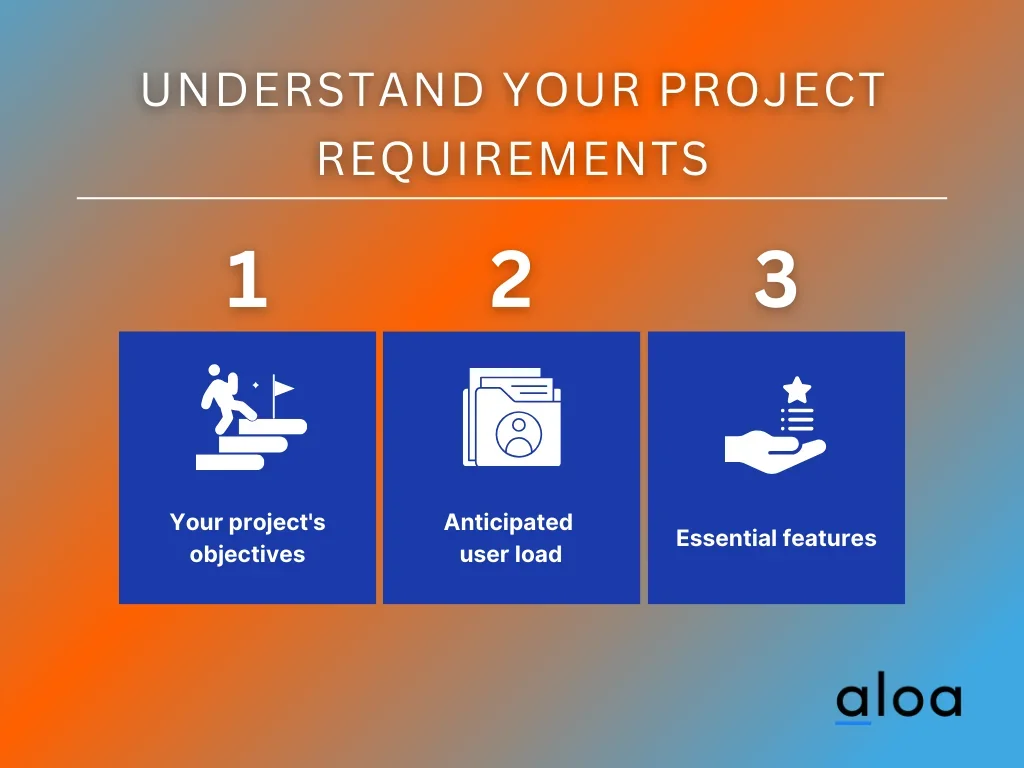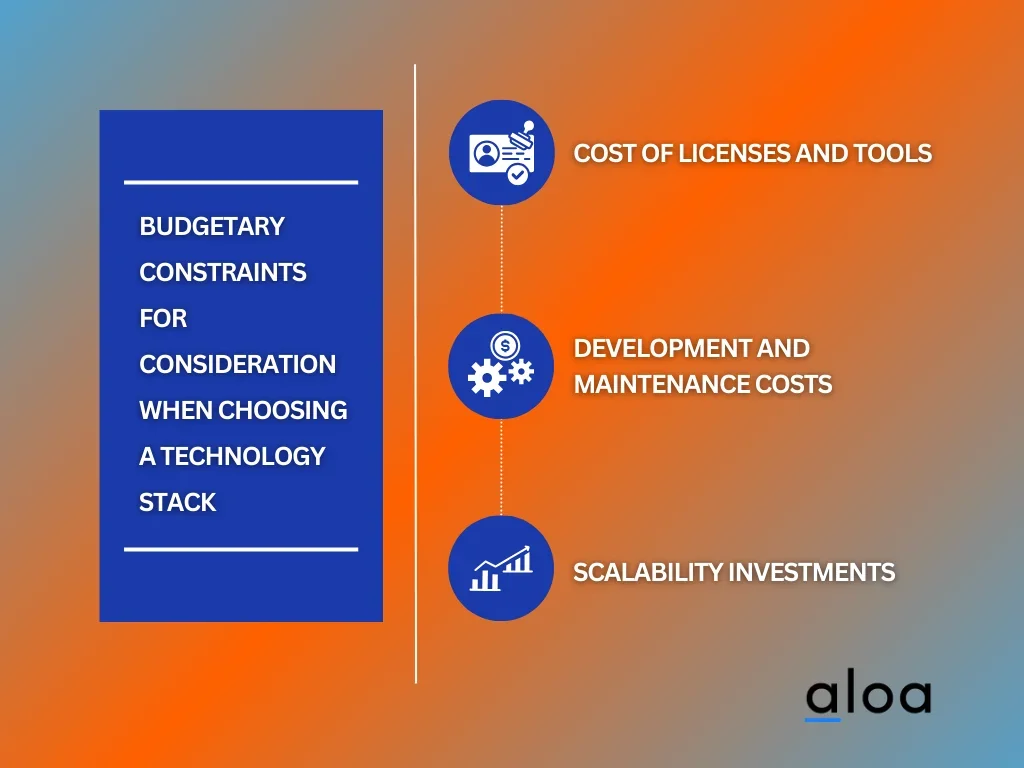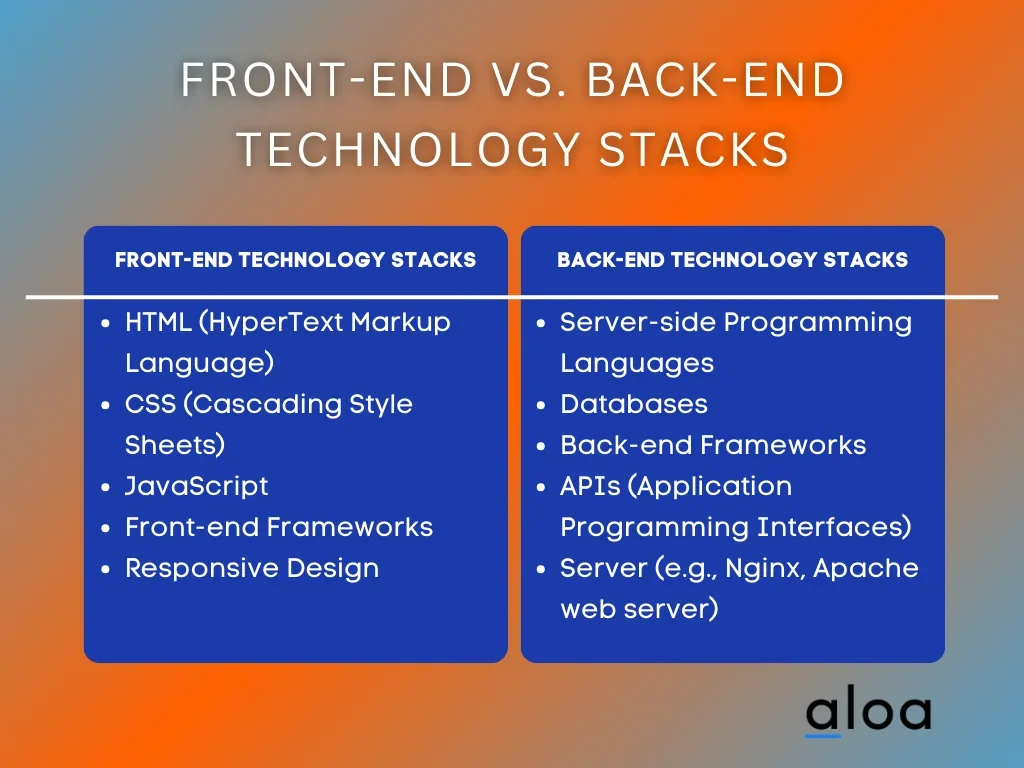In 2024, the landscape of the technology stack has undergone a profound transformation. This evolutionary paradigm not only streamlines the developmental workflow but also establishes a versatile and efficient framework, facilitating the creation of pioneering digital experiences.
However, grasping the standard options within a technology stack becomes particularly important, ensuring developers stay abreast of the latest tools and frameworks to enhance their project's efficiency and competitiveness.
At Aloa, a software outsourcing firm, meticulous attention is given to crafting a tailored technology stack for each project. By strategically selecting software tools and programming languages, Aloa ensures optimal performance and scalability. This commitment to precision empowers clients with robust, efficient digital solutions that meet their unique business needs.
In this blog, we'll explore the basics of technology stacks—what they are and how to choose the right one. We'll break down the differences between front-end and back-end technology stacks, offering insights accessible to everyone interested in understanding the building blocks of modern software.
Let's dive in!
What is a Technology Stack?
A technology stack combines software tools, programming languages, and frameworks used to build and manage applications. It significantly impacts the tech industry by influencing an application's performance, scalability, and overall efficiency, shaping the trajectory of digital innovation and development practices.
The components of a technology stack work harmoniously to create a comprehensive environment for developing and deploying software applications, spanning a broad spectrum from web platforms to mobile apps. This integrated approach ensures a versatile and efficient foundation for crafting diverse software solutions across various platforms. Here's a general overview of the layers typically found in a technology stack:

- Operating System (OS): The operating system serves as the essential foundation for a technology stack, akin to the underlying structure of a building. It provides the necessary environment for software to run smoothly, with choices like Linux, Windows, or macOS influencing factors such as performance and security.
- Server: Acting as the digital traffic controller, servers like Apache or Nginx handle incoming requests, ensuring the smooth delivery of web applications to users. They form a critical layer in the stack, responsible for hosting and managing the flow of information.
- Database: Databases function as organized repositories for application data, comparable to well-structured libraries. MySQL, PostgreSQL, or MongoDB are common choices, with selection based on factors such as data type, scalability, and performance requirements.
- Back-endProgramming Language: Serving as the programming language for server-side logic, choices like Python, JavaScript, Ruby, Java, or PHP act as the architects behind the scenes, determining how applications process and manage data.
- Front-end Framework/Library: Front-end frameworks and libraries, such as React.js, Angular, or Vue.js, act as the creative toolbox for crafting user interfaces. They simplify the development of visually appealing and interactive elements, enhancing the overall user experience of web applications.
These layers empower developers to create robust and user-friendly applications, laying the groundwork for the digital experiences that define our interconnected world.
How To Choose The Right Technology Stack For Your Project
Crafting a successful digital venture starts with selecting the right tech stack that aligns seamlessly with your project's unique needs and technology infrastructure, propelling your development journey forward. Here's a guide on how to navigate the array of different tech stacks and strategically choose the one that best suits your project's requirements.

Step 1: Understand Your Project Requirements
Understanding your project requirements is the cornerstone of selecting the right technology stack. It sets the stage for a tailored, effective technological solution that aligns seamlessly with your development objectives. Begin by conducting a thorough analysis, considering:

- Your project's objectives: Clearly define what you want your project to achieve. Are you aiming for user engagement, data processing efficiency, or seamless scalability?
- Anticipated user load: Estimate how many people will be using your application. This helps choose technologies that can handle the expected traffic, ensuring a smooth user experience.
- Essential features: Identify the must-have functionalities for your application. Whether it's real-time updates, robust security, or interactive interfaces, listing these features guides you in selecting technologies that support your project's core requirements.
This foundational step enables you to pinpoint the specific technological needs of your application. With a clear understanding of your project's requirements, you can confidently choose the technologies that best cater to your development goals.
Step 2: Assess Your Team's Expertise
Assessing your team's expertise is critical in determining the appropriate technology stack for your project. Begin by taking stock of your team's skill sets, including programming languages, frameworks, and tools they are proficient in. A thorough understanding of their strengths and weaknesses will guide you in selecting technologies that align with their expertise, fostering increased productivity and efficient development cycles. Consider the learning curve associated with new technologies; opting for familiar tools can expedite project timelines and reduce the risk of errors.
Engage openly with your team to identify their preferences and comfort levels, ensuring a collaborative and empowering work environment. If skills gaps exist, plan for training or hiring initiatives to bridge them, promoting continuous improvement within your team. An honest evaluation of your team's capabilities ensures a harmonious integration of technology, empowering your developers and enhancing the overall success of your project.
Step 3: Consider Budget Constraints
Budget constraints are a strategic aspect of technology stack selection, ensuring a harmonious balance between project requirements and financial considerations. Delve into the budgetary realm with the following considerations:

- Cost of Licenses and Tools: Evaluate the expenses associated with software licenses, development tools, and proprietary technologies. This transparency aids in steering clear of unforeseen financial hurdles.
- Development and Maintenance Costs: Anticipate the ongoing development costs, including developer salaries, infrastructure expenses, and potential maintenance fees. This foresight allows for realistic budgeting throughout the project's lifecycle.
- Scalability Investments: Factor in the scalability needs of your project. While investing in scalable technologies might incur higher initial costs, it can pay off in the long run by accommodating growth without significant overhauls.
Balancing these budget considerations ensures that your chosen technology stack aligns with your financial parameters, setting the groundwork for cost-effective and successful project implementation.
Step 4: Scalability and Future Growth
Scalability and Future Growth are pivotal considerations when selecting a technology stack for your project. Firstly, a scalable technology stack should seamlessly adapt to increasing workloads and user demands. This involves choosing components that can efficiently handle growth without compromising performance. Secondly, future growth prospects must be carefully evaluated. The selected technology stack should align with your long-term project goals, allowing for easy integration of new features and technologies as your project evolves. A modular and flexible architecture is crucial to accommodate emerging requirements.
Additionally, consider the scalability of your team – a technology stack that supports collaborative development and can quickly onboard new team members ensures sustained growth. Regularly updating and future-proofing the chosen technologies will contribute to the longevity of your project. A well-considered approach to scalability and future growth in your technology stack selection lays the foundation for a robust and enduring project.
Step 5: Community Support and Documentation
Community support and documentation play a pivotal role in the success of your chosen technology stack. Consider the following key points as you evaluate the community backing and documentation of potential technologies:
- Active Community Engagement: Opt for technologies with a vibrant and active community. A robust community ensures a wealth of shared knowledge, troubleshooting resources, and ongoing updates, contributing to the longevity and reliability of your chosen stack.
- Comprehensive Documentation: Prioritize technologies with thorough and easily accessible documentation. Clear documentation streamlines the learning process for your development team, fostering efficient troubleshooting and accelerating the development timeline.
- Online Forums and Discussion Groups: Explore online forums and discussion groups related to the technologies you're considering. Active participation in these communities provides valuable insights, best practices, and real-world experiences other developers share.
By prioritizing community support and documentation in your technology selection, you tap into a valuable network of collective knowledge, ensuring a smoother development journey and enhanced problem-solving capabilities for your team.
Step 6: Security and Compliance
Security and compliance are paramount considerations in selecting a technology stack for your project. First and foremost, the chosen stack must adhere to industry-standard security protocols to safeguard against potential vulnerabilities and cyber threats. Robust encryption mechanisms, secure authentication processes, and regular security updates are essential for ensuring the confidentiality and integrity of sensitive data.
Compliance with relevant regulations and standards also is crucial, especially in industries with stringent legal requirements. The technology stack should facilitate adherence to data protection laws, privacy regulations, and other applicable compliance standards. Regular security audits and assessments must be integrated into the development lifecycle to identify and address vulnerabilities proactively.
Choosing a stack with a strong security track record and a community that prioritizes security measures adds an extra layer of assurance for your project's safety and compliance. Ultimately, a vigilant approach to security and compliance within your technology stack safeguards both your project and the trust of your users.
Step 7: Test and Iterate
Testing and iterating are pivotal stages in strategically selecting an effective technology stack. Consider critical aspects to seamlessly align your project goals and the chosen technologies.
- Small-Scale Testing: Begin by conducting small-scale tests to evaluate how well your chosen technologies perform in a controlled environment. This allows for early identification of potential issues and areas for improvement.
- Performance Metrics: Assess the performance metrics of your technology stack, including factors like speed, reliability, and resource usage. This data helps make informed decisions about the scalability and efficiency of your chosen technologies.
- User Feedback: Solicit feedback from users or stakeholders during testing. Real-world insights from the end-users provide valuable perspectives on the functionality and user experience, guiding refinements in your technology choices.
Incorporating these testing and iteration practices into your selection process ensures that your chosen technology aligns seamlessly with your project's practical needs and expectations.
Front-end vs. Back-end Technology Stacks
Creating a digital experience involves the seamless collaboration of front-end and back-end technology stacks, akin to orchestrating a symphony of code. Let's delve into these essential components, unravel their unique functions, and discover how striking the right balance leads to a harmonious digital presence.

Front-end Technology Stacks
Front-end development serves as the face of the digital realm, focusing on what users directly interact with on web pages. It encompasses languages, frameworks, and tools shaping the user interface (UI) and overall user experience (UX). Standard technologies in the front-end stack include:
- HTML (HyperText Markup Language): Shapes web content structure, providing a standardized markup language for web page layout.
- CSS (Cascading Style Sheets): Determines visual aesthetics by defining colors, fonts, and layouts, enhancing the user interface.
- JavaScript: Adds interactivity, enabling the creation of responsive and engaging user experiences.
- Front-end Frameworks: (e.g., React.js, Angular, Vue.js) Offers a structured environment for efficient UI development with pre-built components and tools.
- Responsive Design: Ensures adaptability to various device sizes, enhancing the user experience across different platforms.
Back-end Technology Stacks
While the front end crafts the user interface, the back end serves as the engine behind the scenes, managing data, user authentication, and overall functionality. Critical components in the back-end stack include:
- Server-side Programming Languages: (e.g., Python, JavaScript, Ruby, Java) Powers server logic, processing user requests, and managing data for smooth web application functioning.
- Databases: Databases, including MySQL, PostgreSQL, MongoDB, and others, not only serve as structured repositories but also play a crucial role in data management and data storage within a comprehensive database management system. This integrated approach ensures efficient data storage and retrieval, contributing to the seamless functionality of every web app.
- Back-end Frameworks: (e.g., Django, Express.js, Ruby on Rails, Laravel) Provides a structured environment for streamlined server-side development, promoting code organization and efficiency.
- APIs (Application Programming Interfaces): Act as bridges, facilitating seamless communication and data exchange between the front and back end.
- Server (e.g., Nginx, Apache web server): Functions as a traffic controller, managing incoming requests and directing them to the appropriate back-end components, ensuring efficient operation for every web and mobile application.
Effective web development requires a harmonious integration of front-end and back-end technologies. Achieving this balance ensures a seamless user experience, responsive design, and efficient data processing. Collaboration between front-end and back-end developers is crucial for aligning the visual presentation with the underlying functionality.
Key Takeaway
Understanding the technology stack and exploring standard options in 2024 gives us a peek into the tools shaping our digital world. Whether it's different languages, robust frameworks, or clever solutions, having the right technology stack is critical to making awesome digital projects. As the modern tech stack changes, staying updated on the latest trends helps developers and businesses pick the best tools for top-notch and modern solutions.
At Aloa, we recognize a well-crafted technology stack's critical role in bringing digital ideas to life. As a leading software outsourcing firm specializing in technology services, we leverage advanced tools and methodologies to build robust solutions. Our talented developers, well-versed in the latest technologies, ensure that your projects meet industry standards and incorporate cutting-edge business intelligence.
If you're ready to turn your project into a digital masterpiece through innovative software development, explore the possibilities with Aloa. Let our expert developers tailor the perfect technology stack for your unique needs. Your vision and our expertise make for the perfect partnership for digital success.

